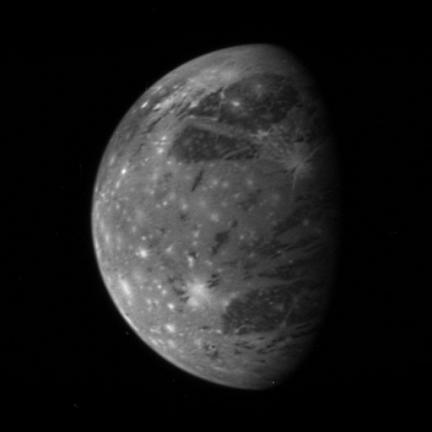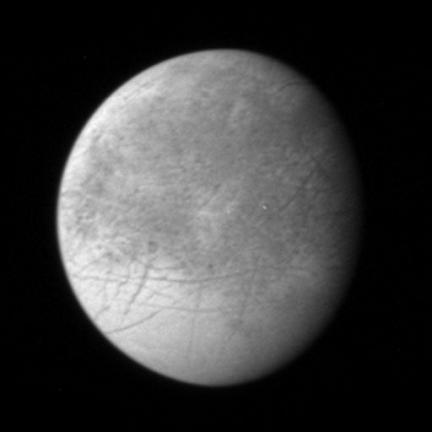An image taken by the Hubble Space Telescope reminds us of how powerful this aging scope really is. Magnitudes sharper than the images originally sent by Pioneer as it passed by in the 1970s.
Ganymede from Juno
Some incredibly sharp images from the Juno mission of Ganymede. The first new views of this beautiful moon since Galileo. See more from kevinmgill on flickr. Also see the thread building up to these full composites in unmannedspaceflight.com.
Ganymede Looking Better, Thanks Ted
Another new near global image of Ganymede by Ted Styrk. He has been producing new views of this Galilean moon for a while now from the old Galileo image sets which were compromised by a glitch that effected the entire mission.
Historic Robotic Spacecraft Poster Survey
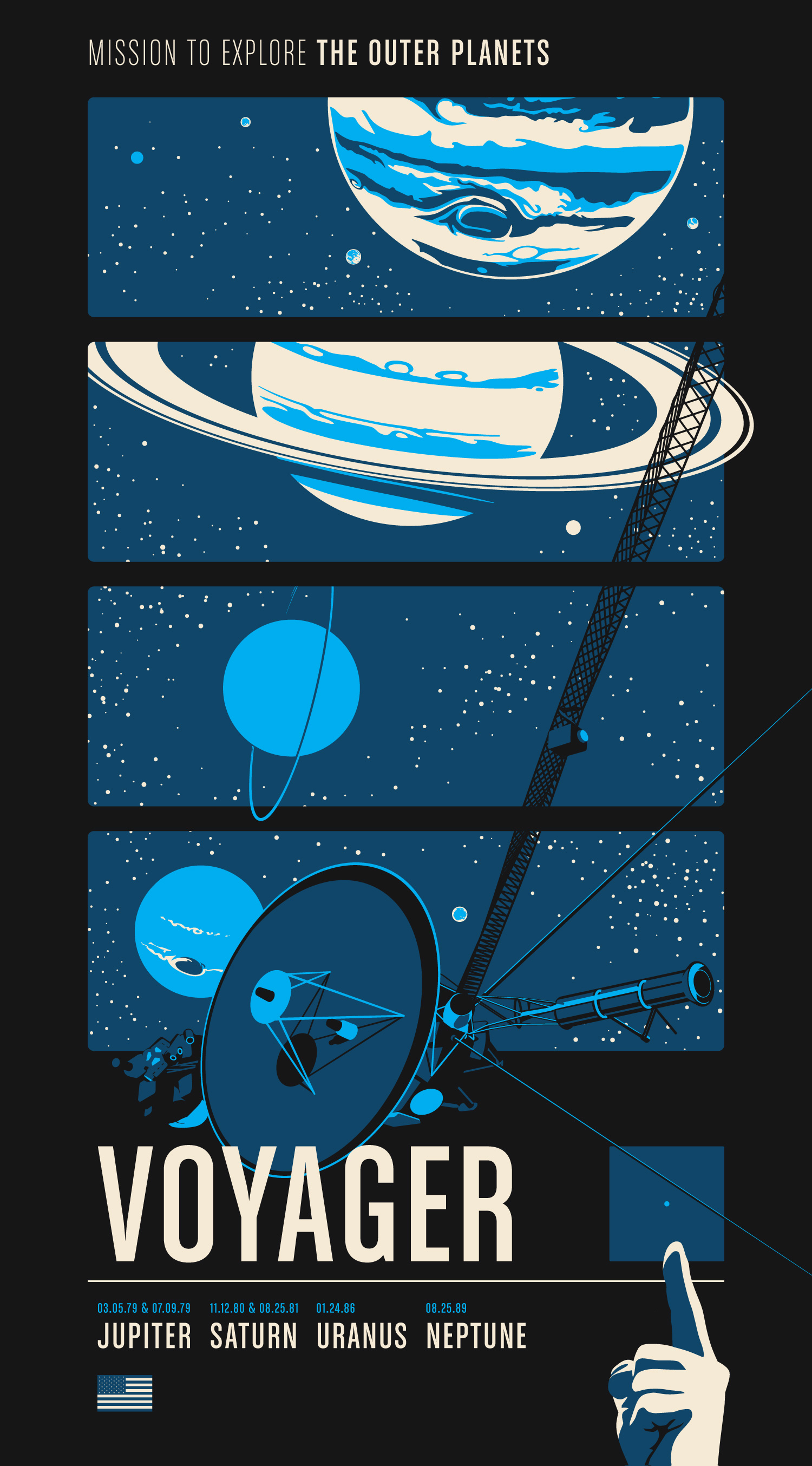 Our new Kickstarter project proposes the creation of three screen-printed posters celebrating the most popular and notable interplanetary robotic space missions in history. Going into this, we knew that poster #1 had to go to the hugely popular Voyager missions (shown above). However, we need your help selecting the themes of posters #2 and #3. So head over to The Planetary Society now to vote on your three favorite missions, but do it by the 19th to have it count for the poster selection. If this goes better than expected we could even wind up designing a fourth or fifth.
Our new Kickstarter project proposes the creation of three screen-printed posters celebrating the most popular and notable interplanetary robotic space missions in history. Going into this, we knew that poster #1 had to go to the hugely popular Voyager missions (shown above). However, we need your help selecting the themes of posters #2 and #3. So head over to The Planetary Society now to vote on your three favorite missions, but do it by the 19th to have it count for the poster selection. If this goes better than expected we could even wind up designing a fourth or fifth.
You Are the Center of the Solar System
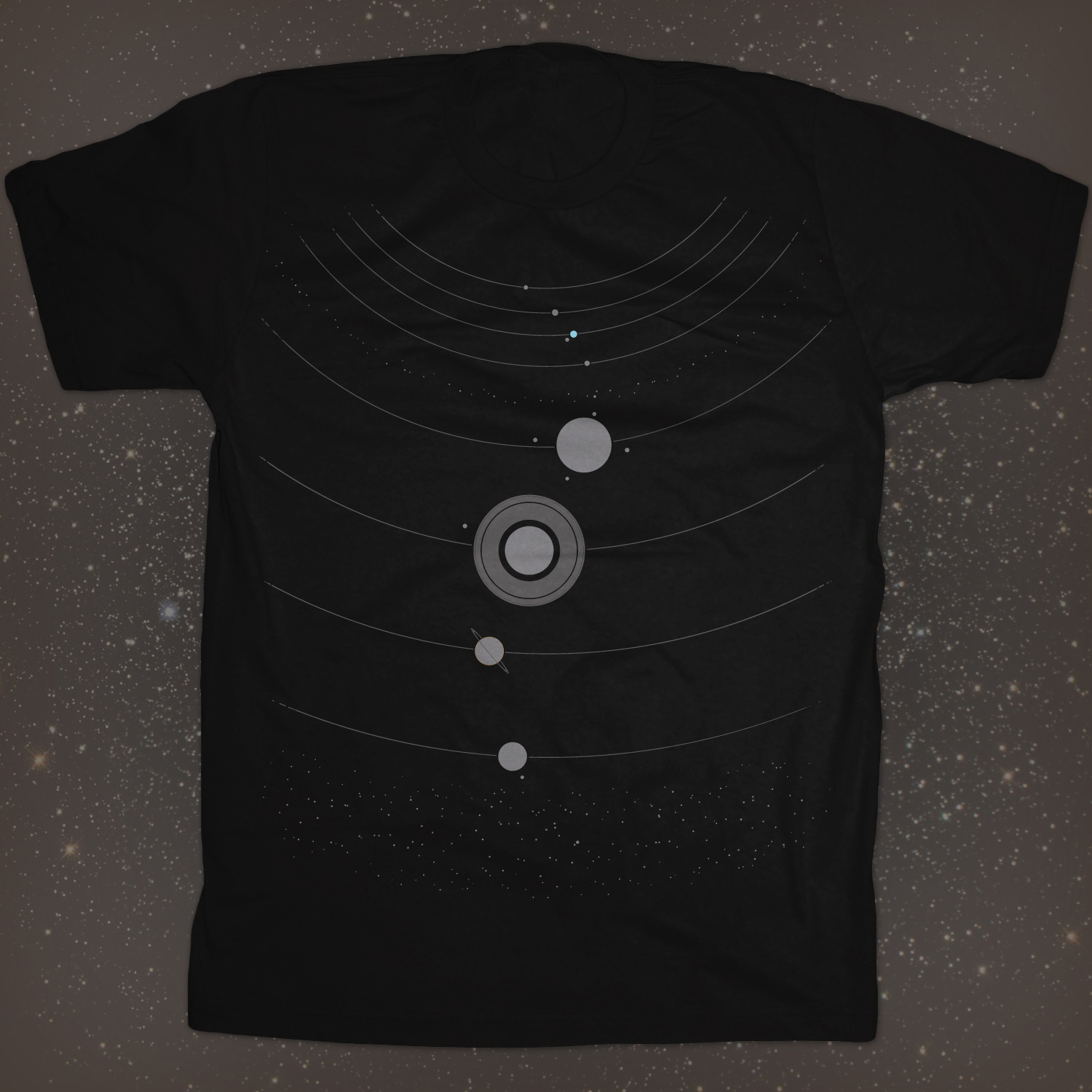 You Are The Sun is the latest space themed tee by Chop Shop Store. Following on iconic tees that collected various deep space missions and historic Earth orbit missions, this new design draws a new picture of The Solar System as we know it today, complete with Carl Sagan’s pale blue dot.
You Are The Sun is the latest space themed tee by Chop Shop Store. Following on iconic tees that collected various deep space missions and historic Earth orbit missions, this new design draws a new picture of The Solar System as we know it today, complete with Carl Sagan’s pale blue dot.

With your head as a stand-in for The Sun — the tee includes all 8 planets, 7 major moons, The Asteroid Belt and even details little Pluto lost among countless Kuiper Belt objects. We are now providing yet another link here to get it for Men on American Apparel 2001 or Tultex tees and for Women on American Apparel 2102 tees.
Ganymede Looking Better, Thanks Ted
 Another new near global image of Ganymede by Ted Stryk. He has been producing new views of this Galilean moon for a while now from the old Galileo image sets which were compromised by a glitch that effected the entire mission.
Another new near global image of Ganymede by Ted Stryk. He has been producing new views of this Galilean moon for a while now from the old Galileo image sets which were compromised by a glitch that effected the entire mission.
50 Years of Space Exploration Map
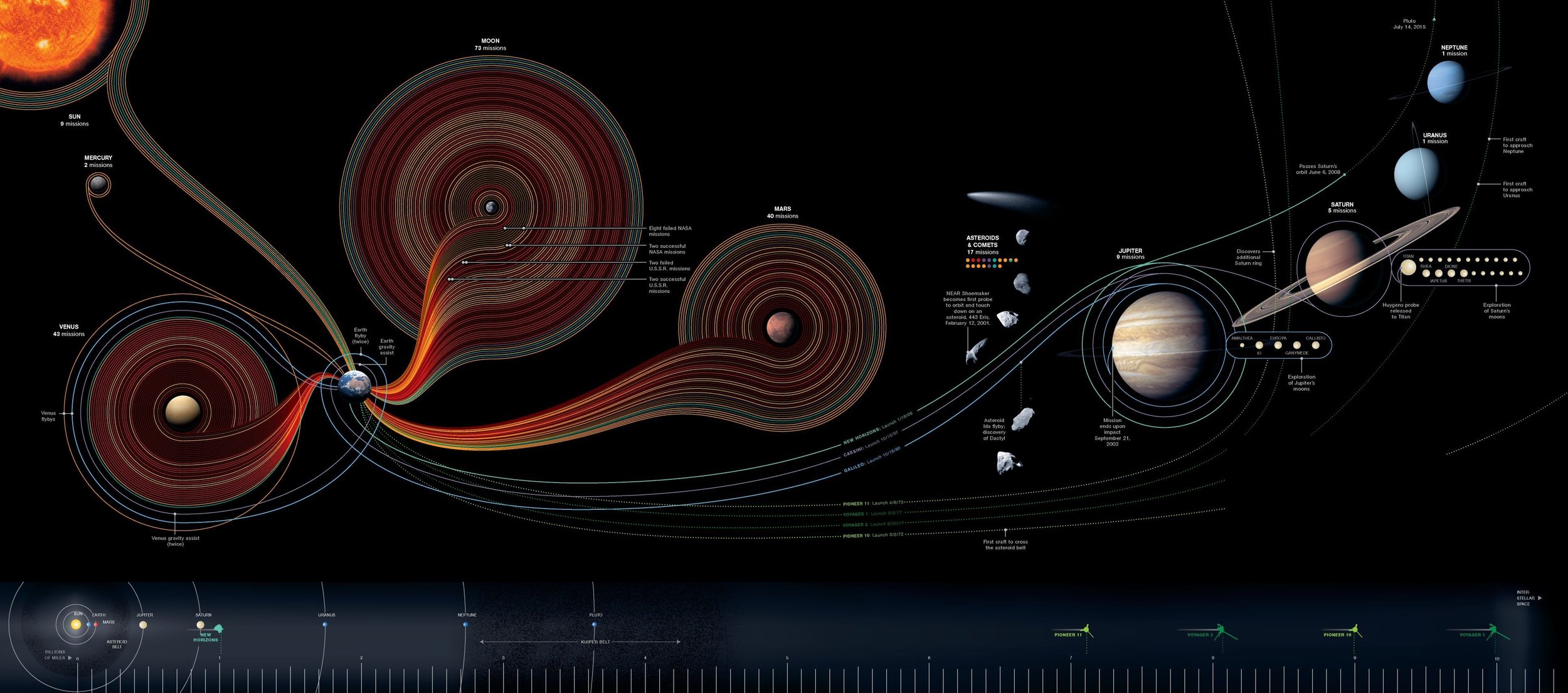 This is so nice, but I am furious that I didn’t get to design this. This is Information design at it’s best naturally by National Geographic. You can see 50 years of robotic planetary exploration at a glance. It even includes failed missions represented by darker desaturated lines. As far as I can tell the cream colored lines are US and the red ones are Soviet. Interesting to see how many of those lines go dark around Mars.
This is so nice, but I am furious that I didn’t get to design this. This is Information design at it’s best naturally by National Geographic. You can see 50 years of robotic planetary exploration at a glance. It even includes failed missions represented by darker desaturated lines. As far as I can tell the cream colored lines are US and the red ones are Soviet. Interesting to see how many of those lines go dark around Mars.
Now where does one purchase such a thing? Perhaps this month’s issue of NG? Here is the link to it on their site complete with zoom viewer and them some kind samaritan posted a hires version to flickr.
Galilean Family Portrait
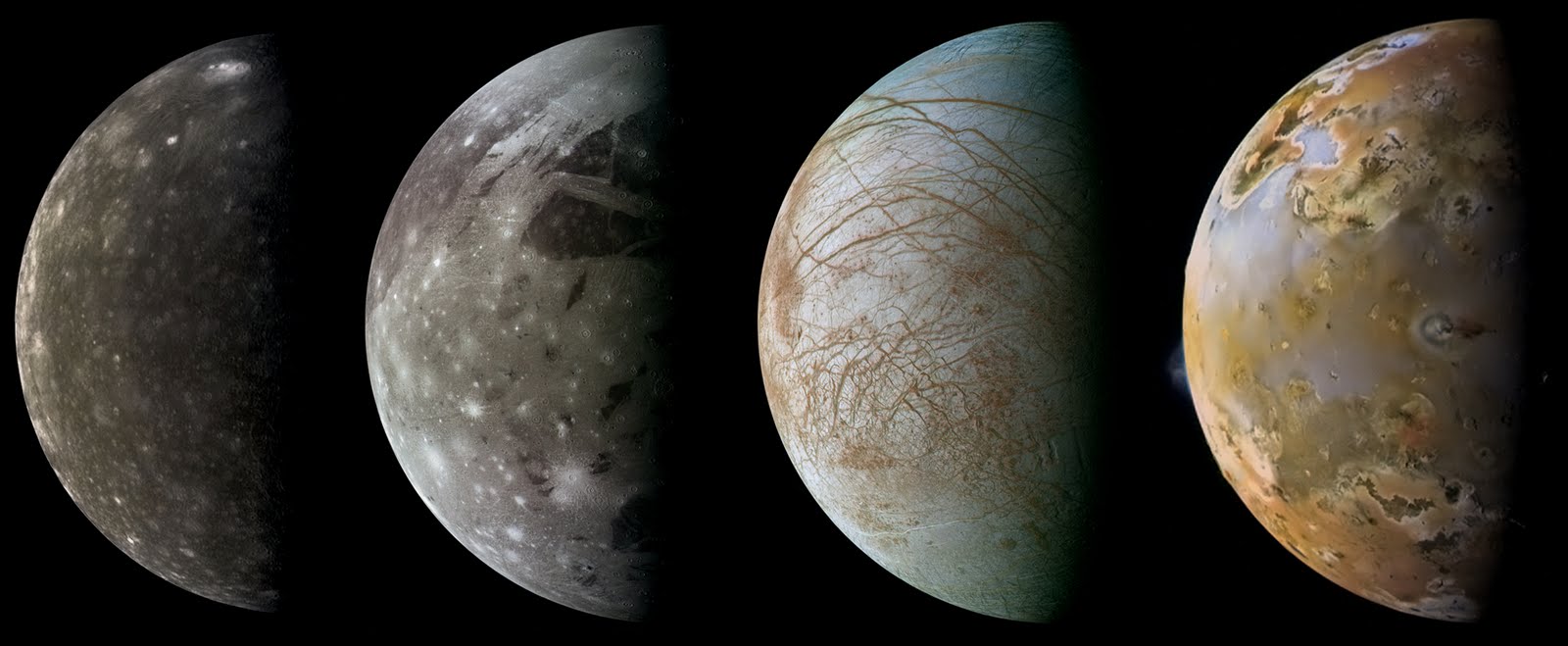 I usually do not go for montages of planets for a variety of reasons, but this family portrait of the 4 Galilean moons of Jupiter is quite gorgeous. They are easily the most fascinating and beautiful bodies of our system of worlds, save for perhaps Saturn and its rings.
I usually do not go for montages of planets for a variety of reasons, but this family portrait of the 4 Galilean moons of Jupiter is quite gorgeous. They are easily the most fascinating and beautiful bodies of our system of worlds, save for perhaps Saturn and its rings.
Another work of art by Ted Stryk whose old blog Planetary Images from Then and Now has come back from the dead with vigor!
iPhone Skins Featured on feulyourcreativity.com
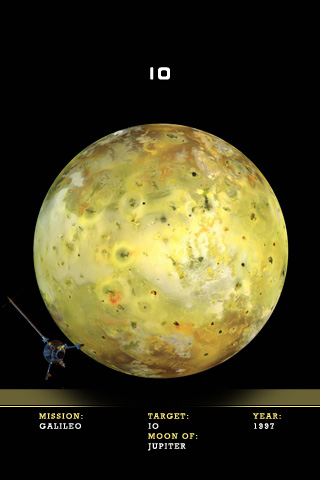 Not to re-post old material, but our iPhone planetary skins were recently posted to fuelyourcreativity.com for free download. So I thought I would just remind everyone and maybe direct a little traffic love their way.
Not to re-post old material, but our iPhone planetary skins were recently posted to fuelyourcreativity.com for free download. So I thought I would just remind everyone and maybe direct a little traffic love their way.
Outer Planets Mission Selected
 It is final. NASA (and ESA) have selected the next flagship mission to the outer planets. The target is the Jupiter system, and by “system” I do mean system. NASA’s side of things will concentrate on a Europa orbiter which will observe Jupiter’s moon in details that we have never seen before. See this youTube video for a good overview. The last time we were near Europa enough to make close observation was with Galileo, but problems with that spacecraft resulted in a limited amount of data that one would expect from such a long orbiter mission such as Galileo.
It is final. NASA (and ESA) have selected the next flagship mission to the outer planets. The target is the Jupiter system, and by “system” I do mean system. NASA’s side of things will concentrate on a Europa orbiter which will observe Jupiter’s moon in details that we have never seen before. See this youTube video for a good overview. The last time we were near Europa enough to make close observation was with Galileo, but problems with that spacecraft resulted in a limited amount of data that one would expect from such a long orbiter mission such as Galileo.
Beyond Europa, the mission will also be close enough to do great observations of its closest neighbor, Io, as well – of course – as it’s host planet Jupiter. Also worth noting is the possible adoption of an Io specific orbiter as part of the New Horizons class of spacecraft whose targets for the next decade have yet to be determined.
Lastly, and certainly not at all a small thing… ESA will be running a Ganymede orbiter to work in tandem with the Europa mission. The two missions are more like partner missions such as the 2 Mars rovers than separate ones. They seem to planning for them both to arrive at the same time (or even launched from the same rocket, is that even possible?).
For those unfamiliar with these bodies, check out these links to other posts about Europa and Ganymede.
Hubble Almost Beats Voyager
 The two 80's Voyager missions to Jupiter were one of the highlights of the decade in planetary missions. There were some images from the two Voyagers that were closer in detail that we can hope to do from Earth orbit, but this image above comes close. You wouldn’t know this was not a Voyager, or even a Galileo mission image except for the fact its not. Hard to imagine that only 20 years ago we couldn’t see a single detail on Ganymede’s surface without actually sending a probe to the Jupiter system. This view from Hubble is, “so sharp that astronomers can see features on Ganymede's surface, most notably the white impact crater, Tros, and its system of rays, bright streaks of material blasted from the crater”.
The two 80's Voyager missions to Jupiter were one of the highlights of the decade in planetary missions. There were some images from the two Voyagers that were closer in detail that we can hope to do from Earth orbit, but this image above comes close. You wouldn’t know this was not a Voyager, or even a Galileo mission image except for the fact its not. Hard to imagine that only 20 years ago we couldn’t see a single detail on Ganymede’s surface without actually sending a probe to the Jupiter system. This view from Hubble is, “so sharp that astronomers can see features on Ganymede's surface, most notably the white impact crater, Tros, and its system of rays, bright streaks of material blasted from the crater”.
Moons of Jupiter on Your Desk
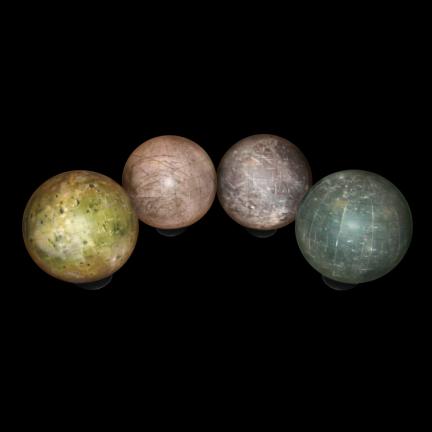 Download this pdf to check out these soon to be produced desktop globes of Jupiter’s moons and contact them about any interest in buying them here. These are cardboard-substrate globes on simple plastic bases, but they still look pretty cool. Even at the high price of $300 (a pre-production estimate) – I have to say that I am pretty tempted.
Download this pdf to check out these soon to be produced desktop globes of Jupiter’s moons and contact them about any interest in buying them here. These are cardboard-substrate globes on simple plastic bases, but they still look pretty cool. Even at the high price of $300 (a pre-production estimate) – I have to say that I am pretty tempted.
New Horizons Opens its Vault
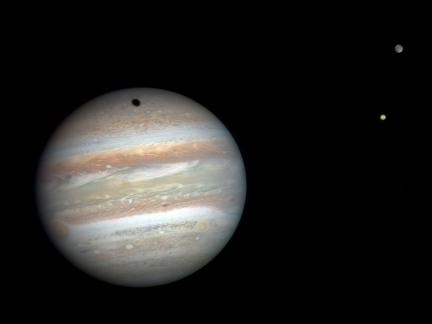 The New Horizons team has made all the MVIC (Multispectral Visible Imaging Camera) images as well as the LORRI (Long Range Reconnaissance Imager) images from the Jupiter encounter available for imagers to kick around. The above image is by Gordan Ugarkovic and is apparently a “colorized” version of a monochrome he created using earth based observations of the planet from around the same time. In addition to the two moons (and a shadow), also visible are both the Great Red Spot as well as the “Red Junior” spot which has in recent months has become a new notable feature of Jupiter.
The New Horizons team has made all the MVIC (Multispectral Visible Imaging Camera) images as well as the LORRI (Long Range Reconnaissance Imager) images from the Jupiter encounter available for imagers to kick around. The above image is by Gordan Ugarkovic and is apparently a “colorized” version of a monochrome he created using earth based observations of the planet from around the same time. In addition to the two moons (and a shadow), also visible are both the Great Red Spot as well as the “Red Junior” spot which has in recent months has become a new notable feature of Jupiter.
The iPhone Set 01: Bodies of Major Interest
 If I am going to keep making these things… I’d be a fool to not include a set for the Apple iPhone. Coincidentally, when you purchase your iPhone and do not yet have a phone service, the phone displays a full-disc image of the Earth pretty much displayed exactly as these do when uploaded to your iPhone. So in the spirit of continuity, you can now opt instead to have Mercury, Venus, Earth, The Moon (Luna), Mars, Jupiter, Io, Europa, Ganymede, Callisto, Saturn, Enceladus, Titan, Iapetus, Hyperion, Uranus, Miranda, Neptune or Triton grace your screen instead of the default Earth.
If I am going to keep making these things… I’d be a fool to not include a set for the Apple iPhone. Coincidentally, when you purchase your iPhone and do not yet have a phone service, the phone displays a full-disc image of the Earth pretty much displayed exactly as these do when uploaded to your iPhone. So in the spirit of continuity, you can now opt instead to have Mercury, Venus, Earth, The Moon (Luna), Mars, Jupiter, Io, Europa, Ganymede, Callisto, Saturn, Enceladus, Titan, Iapetus, Hyperion, Uranus, Miranda, Neptune or Triton grace your screen instead of the default Earth.
The easiest way to install wallpapers to your iPhone is to make a special set in iPhoto and simply drag all the files to that folder. Then in iTunes have your iPhone sync that folder to your photos collection. After that it is as simple as opening the “Photos” area of your iPhone. Go to your new folder of images and open whichever image you want. Then tap on the image just once and assign it as a wallpaper using the “Use as Wallpaper” button in the lower left corner of the screen.
If you have a PC I have no idea in hell how the hell you get images into your iPhone. I would buy a Mac… you have an iPhone and use iTunes… you are half-way there.
For a version of these with no graphics see this link.
2560 x 1600 Set 02 : The Moons of Jupiter
The moons of Jupiter (well, the 4 major ones) are in their own right, a Solar System within a Solar System. There is volcanically explosive Io; Europa with its cracks and ridges hinting at its huge internal ocean; Ganymede the largest moon in our celestial neighborhood and Callisto one the most heavily cratered bodies we have anywhere. The 4 moons are also called the Galilean moons as they were discovered by Galileo and have since been revealed to be more fascinating than most planets are. The images below represent what I think are likely the best representative images of these places that can fill a 2560x1600 screen. At this size, the details are quite impressive… do take a look even if you can’t make use of the images as wallpaper images.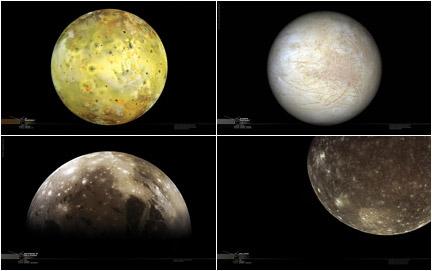
The Europa image is actually a render created by Tayfun Öner as not that many satisfactory images exist of a full globe Europa. Many great images exist of Ganymede but most are low resolutions, this image was stitched together by Ted Stryk of www.unmannedspaceflight.com. The other two are officially released NASA composites.
Wallpaper: Ganymede Up Close
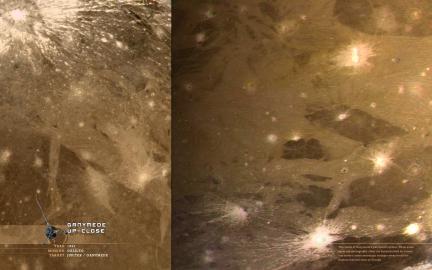 Two views of Ganymede’s patchwork surface taken by Galileo around 1997. While some areas appear geologically older (as demonstrated by the record of impact cratering) some seemingly younger areas recall the fracturous features seen at Europa. Many theorize, just as they do at Europa, that there may be a global ocean of water beneath the surface at Ganymede. However, it is also assumed (if if this does exist) that this ocean would be more shallow and under a much thicker crust of rock hard ice than that of Europa.
Two views of Ganymede’s patchwork surface taken by Galileo around 1997. While some areas appear geologically older (as demonstrated by the record of impact cratering) some seemingly younger areas recall the fracturous features seen at Europa. Many theorize, just as they do at Europa, that there may be a global ocean of water beneath the surface at Ganymede. However, it is also assumed (if if this does exist) that this ocean would be more shallow and under a much thicker crust of rock hard ice than that of Europa.
New Horizons Spies Ganymede and Europa
Wallpaper: Ganymede Portrait
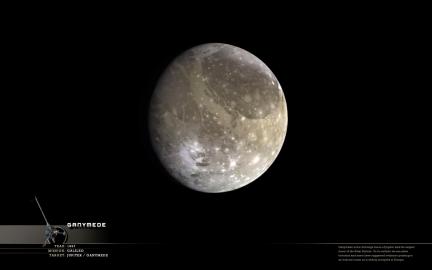 The largest of all the moons in the solar system is actually larger than the planet Mercury. The moon also shows evidence to tectonic plates (the same process that causes earthquakes on Earth) and there may even be some underground ocean as on Europa though it is less likely to be nearly as extensive. Recent observations from the Hubble Space Telescope suggest that there may be a tenuously thin atmosphere of pure oxygen at Ganymede due to the radiating of water ice into oxygen and hydrogen. In this scenario the hydrogen is lost to space while the oxygen (being a heavier element) is retained at the surface.
The largest of all the moons in the solar system is actually larger than the planet Mercury. The moon also shows evidence to tectonic plates (the same process that causes earthquakes on Earth) and there may even be some underground ocean as on Europa though it is less likely to be nearly as extensive. Recent observations from the Hubble Space Telescope suggest that there may be a tenuously thin atmosphere of pure oxygen at Ganymede due to the radiating of water ice into oxygen and hydrogen. In this scenario the hydrogen is lost to space while the oxygen (being a heavier element) is retained at the surface.
Wallpapers: Ganymede at Half Phase
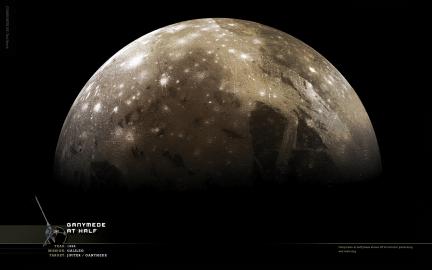 Ganymede in the best “disk” detail I have ever seen. There are some great close up images of Ganymede, but for some reason most of the images that show the moon from a distance are usually blurry and lack the detail you see here. This composite is by Ted Stryk but the trick is that his original was only in black and white, so I ham-handedly used other images of Ganymede to colorize it. So… the color here is interpretive and not based upon actual data.
Ganymede in the best “disk” detail I have ever seen. There are some great close up images of Ganymede, but for some reason most of the images that show the moon from a distance are usually blurry and lack the detail you see here. This composite is by Ted Stryk but the trick is that his original was only in black and white, so I ham-handedly used other images of Ganymede to colorize it. So… the color here is interpretive and not based upon actual data.




